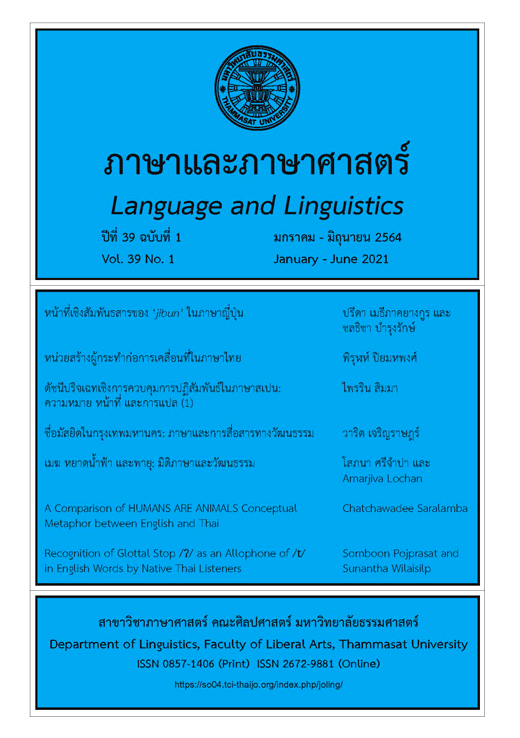Caused-Motion Constructions in Thai
Main Article Content
Abstract
Motion of objects is one of the most fundamental human experiences. This event can be categorized into various subtypes, one of which is caused motion. Language users encode this caused motion event through linguistic representations termed caused-motion constructions. These constructions have received much attention in both English and Chinese linguistics. However, there is no research to date that has thoroughly investigated caused-motion constructions in Thai. The current research has two specific purposes: to identify syntactic structures and constructional meaning of caused-motion constructions in Thai and to demonstrate the correspondence between the posited syntactic structures and constructional meaning. The researcher collected the data from the Thai National Corpus under the Patronage of Her Royal Highness Princess Mahachakri Sirindhorn (TNC). Analyses reveal that syntactic structures of caused-motion constructions in Thai are divided into three subtypes: (1) prepositional construction, (2) serial verb construction, and (3) prepositional and serial verb construction. These constructions carry shared constructional meaning: an agent performs a certain action causing a theme or an object to move from a particular source or to a specific goal. Each syntactic structure demonstrates a direct relationship to different aspects of constructional meaning. The first construction corresponds to the entire constructional meaning as seen from the prepositional phrase marking locational source or goal of motion. The second construction portrays two consecutive subevents (caused-motion subevent from the first verb and motion event from the second verb). The last construction encodes two successive subevents like the second construction but the second verb is followed by the prepositional phrase marking locational source or goal comparable to the first construction.
Article Details
บทความทุกบทความเป็นลิขสิทธิ์ของภาษาและภาษาศาสตร์
References
กันตณัฐ ปริมิตร. (2559). หน่วยสร้างภาคแสดงพรรณนาเหตุการณ์ตั้งวางและหยิบฉวยวัตถุในภาษาไทย [วิทยานิพนธ์ปริญญามหาบัณฑิต]. จุฬาลงกรณ์มหาวิทยาลัย.
จรัสดาว อินทรทัศน์. (2539). กระบวนการที่คำกริยากลายเป็นคำบุพบทในภาษาไทย [วิทยานิพนธ์ปริญญาดุษฎีบัณฑิต]. จุฬาลงกรณ์มหาวิทยาลัย.
ราตรี แจ่มนิยม. (2546). การศึกษาคำบุพบทที่กลายมาจากคำกริยาในภาษาไทย [วิทยานิพนธ์ปริญญามหาบัณฑิต]. มหาวิทยาลัยศิลปากร.
อมรา ประสิทธิ์รัฐสินธุ์. (2553). ชนิดของคำในภาษาไทย: การวิเคราะห์ทาง วากยสัมพันธ์. โรงพิมพ์จุฬาลงกรณ์มหาวิทยาลัย.
Boas, H. C., & Höder, S. (2018). Construction grammar and language contact: An introduction. In H. C. Boas & S. Höder (Eds.), Constructions in contact constructional perspectives on contact phenomena in Germanic languages (pp. 5-36). John Benjamins Publishing.
Brown, K., & Miller, J. (2013). The Cambridge dictionary of linguistics. Cambridge University Press.
Chin, C. O. (2011). Grammaticalization of the Cantonese double object verb [pei(35)] in typological and areal perspectives. Language and Linguistics, 12(3), 529-563.
Croft, W. (2001). Radical construction grammar: Syntactic theory in typological perspective. Oxford University Press.
Crystal, D. (2008). Dictionary of linguistics and phonetics. Wiley-Blackwell.
Evans, V., & Green, M. (2006). Cognitive linguistics: An introduction. Psychology Press.
Fong, R. (2020). Caused-motion constructions in Chinese: A constructional-cognitive analysis. Ampersand, 7, 100059.
Fukui, R. (2016). Idiomaticity of the English caused-motion construction and the figure-ground organization of the postverbal elements. 茨城県立医療大学紀要, 21, 27-31.
Goldberg, A. E. (1995). Constructions: A construction grammar approach to argument structure. University of Chicago Press.
Goldberg, A. E. (1999). The emergence of the semantics of argument structure constructions. In B. MacWhinney (Ed.), The emergence of language (pp. 197-212). Taylor & Francis.
Goldberg, A. E. (2002). Surface generalizations: An alternative to alternations. Cognitive Linguistics, 13(4), 327-356.
Haiman, J. (1985). Iconicity in syntax. Proceedings of a Symposium on Iconicity in Syntax, Stanford, June 24-26, 1983. John Benjamins Publishing.
Haspelmath, M. (2016). The serial verb construction: Comparative concept and cross-linguistic generalizations. Language and Linguistics, 17(3), 291-319.
Hwang, J. D., & Palmer, M. (2015). Identification of caused motion construction. In M. Palmer, G. Boleda, & P. Rosso (Eds.), Proceedings of the Fourth Joint Conference on Lexical and Computational Semantics (pp. 51-60). https://www.aclweb.org/anthology/volumes/S15-1/
Joo, I., & Liu, M. (2020). Caused-motion and caused-position: Syntactic patterns and semantic networks. Studies in Language.
Kodama, K. (2004). The English caused-motion construction revisited--A cognitive perspective. 言語科学論集= Papers in linguistic science, 10, 41-54.
Kroeger, P. R. (2005). Analyzing grammar: An introduction. Cambridge University Press.
Langacker, R. W. (2008). Cognitive grammar: A basic introduction. Oxford University Press.
Langacker, R. W. (2009). Constructions and constructional meaning. In V. Evans & S. Pourcel (Eds.), New directions in cognitive linguistics (pp. 225-267). John Benjamins Publishing.
Lin, J. (2019). Encoding motion events in Mandarin Chinese: A cognitive functional study. John Benjamins Publishing.
Narasimhan, B., Kopecka, A., Bowerman, M. F., Gullberg, M., & Majid, A. (2012). Putting and taking events: A crosslinguistic perspective. In A. Kopecka & B. Narasimhan (Eds.), Events of putting and taking: A crosslinguistic perspective (pp. 1-18). John Benjamins Publishing.
Narrog, H. (2010). A diachronic dimension in maps of case functions. Linguistic Discovery, 8(1), 233-254.
Perek, F. (2015). Argument structure in usage-based construction grammar: Experimental and corpus-based perspectives. John Benjamins Publishing.
Rappaport Hovav, M. & Levin, B. (1998). Building verb meanings. In M. Butt & W. Geuder (Eds.), The projection of arguments: Lexical and compositional factors (pp. 97-134). CSLI Publications.
Rice, S., & Kabata, K. (2007). Crosslinguistic grammaticalization patterns of the allative. Linguistic Typology, 11(3), 451-514.
Talmy, L. (2000). Toward a cognitive semantics. MIT Press.
Thepkanjana, K. (2010). Ditransitive constructions in Thai. In M. Haspelmath, B. Comrie, & A. Malchukov (Eds.), Studies in ditransitive construction: A comparative handbook (pp. 409-426). De Gruyter Mouton.
Timyam, N., & Bergen, B. K. (2010). A contrastive study of the caused-motion and ditransitive constructions in English and Thai: Semantic and pragmatic constraints. In H. C. Boas (Ed.), Contrastive studies in construction grammar (pp. 137-168). John Benjamins Publishing.
Traugott, E. C. (2015). Toward a coherent account of grammatical constructionalization. In J. Barðdal, E. Smirnova, L. Sommerer, & S. Gildea (Eds.), Diachronic construction grammar (pp. 51-80). John Benjamins Publishing.
Traugott, E. C., & Trousdale, G. (2013). Constructionalization and constructional changes. Oxford University Press.
Wang, W. (2015). The semantic map of the spatial motion domain and related functions. Language and Linguistics, 16(3), 465–500.


